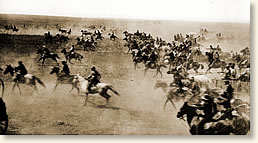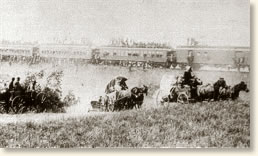|
The Great Oklahoma Land Rush of
1893
At precisely twelve noon on September 16, 1893 a cannon's boom unleashed the largest land rush America ever saw. Carried by all kinds of transportation - horses, wagons, trains, bicycles or on foot - an estimated 100,000 raced to claim plots of land in an area of land in northern Oklahoma Territory known as the Cherokee Strip. There had been a number of previous land rushes in the Territory - but this was the big one.
 |
| The Great Land Rush Begins |
In 1828 Congress designated the land that would become Oklahoma as Indian Territory. White settlers were required to leave, and a number of tribes from the East and South were forcibly moved into the area from their ancestral lands. Chief among these were the Five Civilized Tribes - the Cherokee, Choctaw, Chickasaw, Creek and Seminole - who allied themselves with the South during the Civil War. Following the war, the US government looked upon these tribes as defeated enemies. This animosity combined with increasing pressure to open up the Indian Territory to white settlement prompted the first land rush in 1885, a second followed in 1889.
By the time of the Oklahoma land rush of 1893, America was in the grip of the worst economic depression it had ever experienced. This was one of the factors that swelled the number of expectant land-seekers that day. Many would be disappointed. There were only 42,000 parcels of land available - far too few to satisfy the hopes of all those who raced for land that day. Additionally, many of the "Boomers" - those who had waited for the cannon's boom before rushing into the land claim - found that a number of the choice plots had already been claimed by "Sooners" who had snuck into the land claim area before the race began. The impact of the land rush was immediate, transforming the land almost overnight.
Choosing to ride their bicycles, Seth Humphrey and his brother joined the mad rush that day - not to race for land, but just for fun. We join his story in the moments just before the starting guns unleash a mad dash for land:
"At last the eventful morning broke, a day exactly like all the rest, hot and dry, a south wind rising with the sun dead ahead, and a hard proposition for bicyclists. We had stayed overnight in the little hotel of a town within a mile of the border, several of us in one room; but at least we two of the bicycle corps did not have to mix up with the jam of horses about the place. And we had another decided advantage in not having horses to look after in a hot prairie wilderness where there was not a well, scarcely a stream not gone to a dry bed, and only an occasional water tank on the one railroad running south to Texas. This water would be of service only to the comparative few who could locate near by.
...A quarter to twelve. The line stiffened and became more quiet with the tension of waiting. Out in front a hundred yards and twice as far apart were soldiers, resting easily on their rifles, contemplating the line. I casually wondered how they would manage to dodge the onrush; perhaps they were wondering that too. The engine, a few hundred feet away, coughed gently at the starting line; its tender and the tops of its ten cattle cars trailing back into the state of Kansas, were alive with men. Inside the cars the boomers were packed standing, their arms sticking out where horns ought to be...
Five minutes. Three minutes. The soldiers now stood with rifles pointing upward, waiting for the first sound of firing to come along their line from the east. A cannon at its eastern end was to give the first signal; this the rifles were to take up and carryon as fast as sound could travel the length of the Cherokee Strip.
All set!
At one minute before twelve o'clock my brother and I, noticing that the soldier out in front was squinting upward along his rifle barrel and intent on the coming signal, slipped out fifty feet in front of the line, along the railroad embankment. It was the best possible place from which to view the start. It has been estimated that there were somewhere around one hundred thousand men in line on the Kansas border. Within the two-mile range of vision that we had from our point of vantage there were at least five thousand and probably nearly eight.
Viewed from out in front the waiting line was a breath-taking sight. We had seen it only from within the crowd or from the rear. The back of the line was ragged, incoherent; the front was even, smooth, solid. It looked like the line-up that it was. I thought I had sensed the immensity of the spectacle, but that one moment out in front gave me the unmatched thrill of an impending race with six thousand starters in sight.
First in the line was a solid bank of horses; some had riders, some were hitched to gigs, buckboards, carts, and wagons, but to the eye there were only the two miles of tossing heads, shiny chests, and restless front legs of horses.
 |
With the train in the background,
waggoners rush from the start line. |
While we stood, numb with looking, the rifles snapped and the line broke with a huge, crackling roar. That one thundering moment of horseflesh by the mile quivering in its first leap forward was a gift of the gods, and its like will never come again. The next instant we were in a crash of vehicles whizzing past us like a calamity...
The funniest of all the starters was the engine with its ten carloads of men. From our stand fifty feet directly in front of it I was contemplating it as the chief absurdity of the race when the rush began. The engine tooted incessantly and labored hard, but of course she could not get under way with anything like the quickness of the horses...
Of course everybody on the train was mad with excitement, particularly since they were packed in without a chance to vent their emotions in any but some noise-making way. With the first toots of the engine came revolver shots from the crowds all along the tops of the cars, and at least a few from those penned up inside. The fusillade, which kept up all the while the train was pulling out past us, had a most exhilarating effect; my old gun, I suddenly noticed, was barking with the rest of them...
A little before midnight, we woke to a distant clatter of hoofs, shouting, and shooting. 'Number - section - township - range -. Keep off and get off!' Then crack! crack! went the rifles, after each call, from the pretty country we had been admiring at sundown...
After a hearty breakfast we pumped up our sorry tires and packed up to start south for the town sites. Ever since daybreak boomers had been straggling northward, bound for Kansas and all points east. One young fellow who stopped for a moment while we were eating breakfast was a fair sample of this crowd... He had staked a claim in our nice little valley, along with a half dozen others on the same tract; and of course, as in such cases all over the Strip, nobody under heaven could know who had arrived first. But for him the delicate question had been settled by the gay horsemen in the pitch darkness of the night before. By the time they were through with him he felt assured that he must have arrived about a week late.
'I wouldn't live here next to such neighbors, anyway,' he told us with considerable heat. At this safe distance and in the daylight his feelings had turned to indignation, but he was still trembling a little."
References:
This eyewitness account appears in Humphrey, Seth King, Following the Prairie Frontier (1931); Davis, William C., The American Frontier (1992).
How To Cite This Article:
"The Oklahoma Land Rush of 1893," EyeWitness to History, www.eyewitnesstohistory.com (2006).
|






